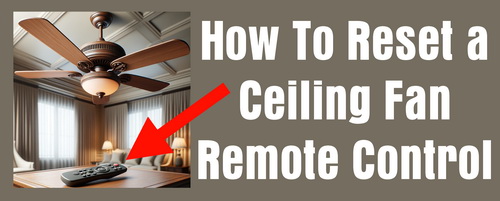Is your ceiling fan remote not controlling the fan? It’s not responding or maybe the controls do nothing when you press them. A reset and some troubleshooting can get the fan working again. Here is the process of resetting your ceiling fan remote control and more.

When Should You Reset Your Ceiling Fan Remote?
There could be a few signs that your remote needs a reset:
- Buttons aren’t responding.
- Fan speed isn’t changing correctly.
- The fan or light turns on and off unexpectedly.
- You’ve changed the batteries or there was a power outage, and now the remote isn’t working properly.
Tools and Materials Needed
- Screwdriver
- New batteries
- Digital Camera (for checking infrared signals)
Five Methods To Troubleshoot A Ceiling Fan Remote
1. Replace the Batteries
Remove the old batteries from the remote control and replace them with new ones to ensure that the issue isn’t due to dead batteries.
2. Check for Interference
Ensure no other electronic devices are interfering with the remote control’s signal, which can prevent it from communicating with the ceiling fan.
3. Reset the Remote Control
Locate the reset button on the remote, press and hold it for about 3-5 seconds. If there’s no reset button, disconnect power to the ceiling fan, wait for about 30 seconds, then reconnect power and within 30 seconds, press and hold the off button on the remote for about 10 seconds.
4. Re-Pair the Remote to the Ceiling Fan
Follow the manufacturer’s instructions to re-pair the remote control with the ceiling fan to ensure proper communication between the two.
How to pair your ceiling fan remote
5. Test the Remote Control’s Infrared Signal
Be sure the remote is shooting a signal. Use a digital camera to check if the remote is emitting an infrared signal when buttons are pressed. The camera can pick up the infrared signals as light flashes on its screen.
Reasons A Fan Remote Has Stopped Working
Signal Interference: Other electronic devices or a crowded radio frequency band could interfere with the signal, preventing the remote from functioning properly.
Misalignment or Poor Range: The remote control needs to be within a certain range of the receiver to function properly.
Failed Remote Control or Receiver: Over time, the remote control or the receiver in the ceiling fan may fail, requiring replacement.
Dirty or Obstructed Remote Control Sensor: Dust or debris can block the remote control’s sensor, preventing it from working properly.
Incorrect Pairing: The remote control and ceiling fan may become unpaired due to a power outage or other electrical disturbance, requiring re-pairing.
More Ceiling Fan Remote Control Tips
What if the ceiling fan controller is not working
The ceiling fan controller/receiver is a crucial part that talks between your remote and the fan. If the controller has issues, it can make it seem like the remote isn’t working. For example, you press the button to speed up the fan, but nothing changes. This could be because the controller isn’t passing the remote’s commands to the fan. A faulty controller can also send wrong signals, making the fan behave oddly. So, if your remote isn’t working right, the problem might be with the controller, not just the remote.
How do I replace the ceiling fan controller
Switch off the power from the circuit breaker to negate any electrical hazards. Open the fan’s housing to access the controller, carefully disconnecting the wires. Replace the old controller with the new one, connecting the wires as per the manual’s instructions. Secure the new controller in place, reattach the housing, and restore the power. Test the fan to confirm the new controller operates correctly.
Can I use any remote control with my ceiling fan
It’s advisable to use the remote control provided by the manufacturer or a compatible one to ensure proper communication. If you have lost your original remote, there are other universal remote controls that can control ceiling fans.
How often should I replace the batteries in my remote control
The frequency depends on usage however it’s advisable to check and replace batteries at least once a year.
Can the range of the remote control affect its operation
Yes, the remote needs to be within a certain range of the receiver to function properly.
How do I clean my remote control sensor
Gently wipe the sensor with a soft, lint-free cloth to remove dust and debris.
Are there any other devices that could interfere with my remote’s signal
Other remotes, electronic devices, or even WiFi routers could potentially interfere with the signal.
If you need more help, please ask your question below in the comments section and I will get back to you with a solution. Thanks!



Leave a Reply